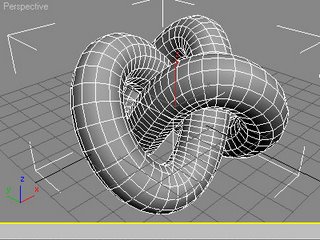A couple of mathematically related diaries taken from the Daily Kos: the first is about ecology and discusses some of the mathematical models. The second is about Bayes' law.
I will warn the reader that there are some politics in these diaries; I thought about trying to edit it out but then decided to leave them "as is."
First, a diary from Jmknapp from the Daily Kos.
http://www.dailykos.com/story/2006/6/29/22011/9126Mathematical Challenges of Global Ecology 
Thu Jun 29, 2006 at 07:00:11 PM PDT
All this week a group of climate scientists have been meeting for a Global Ecology workshop at Ohio State University. Abstracts of some of the talks can be found at OSU Mathematical Biosciences Institute
* Marine Carbon Cycle Biogeochemistry from the Bottom Up
* Quantifying the Predictability of Noisy Nonlinear Biogeochemical Systems
* Ecosystem-climate dynamics: What are the phenomena that pose mathematical challenges?
* Stoichiometry of wild plants and crops in the high CO2 world
...etc.
I attended a lot of the talks, to get a feel for current thinking on the global warming crisis and to watch these scientists in action, on the global warming front line.
The conference generally steered clear of political issues, being concerned with more heady topics like transcritical bifurcations in systems of ordinary differential equations, oscillating relationships in predator-prey populations, hysteresis and catastrophic jumps in system behavior, maximum entropy production models, Navier-Stokes equations, ecological stoichiometry, Redfield ratios of C:N, eigenvalues of Jacobian matrices--fun stuff like that.
Still, it was interesting that Bush would come up from time to time and it was evident that the Bush administration is regarded with total disdain by these scientists. Not surprising, given the all-out assault on science that Bush has led, from evolution to the Big Bang to global warming.
One presenter included a Bush photo in one of his slides:

Underneath the photo was the relationship:
plant -> herbivore + waste
That got quite a few chuckles. Also below the photo was the statement: organisms are just abstract molecules
That thought, the speaker said, "is the only thing getting me through the last administration and a half." Another quipped, "It looks like he's saying 'you know where you can stick it!'"
During a talk on stability (or instability) of the global climate over Earth's history, the speaker noted that elements of the climatic system develop "without foresight, much like Republicans."
So this ire is definitely directed at Republicans and not all politicians. This is cutting the Democrats some slack, as I recall it was Congressional Democrats who scuttled Gore's carbon tax early on in the Clinton Administration. But still, Republicans are just so egregious in these areas that even an adminstration that "offered a friendly ear" is infinitely preferable. Several pointed out that however that a carbon tax, which could be designed to be revenue neutral, would be a great step towards mitigation of CO2 emissions. So Democrats need to pick up the ball there.
Gore's movie was seen by most. One esteemed professor from the University of Minnesota said, "I learned a few things. Gore was very careful with the science." Also, "The idea that someone could make a movie of a lecture and people would go to see it!" As for Gore's personal stories in the film, "If you want to present an interesting lecture you should include some personal anecdotes." An Oak Ridge scientist organized a group of his colleagues from the Carbon Dioxide Information Center to see the movie & it was very well received.
Dr. John Pastor gave a talk illustrating how there are several time constants involved in CO2 dynamics, and how perturbations in the climate can persist long after the stimulus is removed, so-called reactive transient responses. It is not known whether increased CO2 currently will produce such a response, even if emissions are curtailed.
Dr. John Harte (UC-Berkeley) points out that Milankovich (orbital) cycles explain the timing of the shifts in the CO2/temperature record over the last 400,000 years or more, but those orbital cycles don't explain the magnitude of the temperature changes, which involve various positive feedback factors making the swings larger. He wonders if perhaps the current trend of making models more and more complex, requiring supercomputers to crunch Navier-Stokes equations and the like, involving hundreds of thousands of variables (the GCM model) might need to be rethought, in favor of simpler mathematical techniques, e.g., current explorations of maximum entropy models.
Dr. Rob Armstrong (SUNY/Stonybrook) says that "the patient is sicker than we thought." He points out that acidification of the oceans (as they absorb CO2 and form carbonic acid) may ultimately dwarf global warming effects in terms of ecological damage (coral reef destruction, dead zones). This acidification is a positive-feedback mechanism for atmospheric CO2 levels, as acidified water is less able to absorb CO2, meaning the oceans become less effective as a buffer. Current pH levels are lower (more acid) than any time in the Vostok ice core record (400,000 years) and perhaps several million years.
Dr. Irakli Loladze (Ohio State) explored the effect of increased CO2 on plant growth and nutrient concentrations. Increased CO2 leads to non-uniform changes in N, P, K, S, Ca, Fe, Zn, Cu and many other trace nutrients. Studies have shown that doubling CO2 can lead to 30-40% boost in biomass, and reduce transpiration of water by 23%. However, much of the world suffers from "hidden hunger," that is, bellies are full but nutrient deficiencies exist, leading to anemia, cretinism, infant and maternal mortality, low birth weight, goiter and other maladies. In the US we have supplements to take up the slack, but in other countries like Bangladesh, 97% of calories come from plants (rice primarily) and natural nutrient levels are critical. Most of the trace elements in plants are lower today than heretofore. As a rule of thumb, doubling CO2 causes trace elements (other than C, O and N) to drop by 10%.
Loladze says that cities like Phoenix currently have up to 600 ppm CO2 levels due to the abundance of cars and the formation of CO2 domes over the city.
Corn productivity is up ten-fold, leading to a glut of nutritionally deficient corn on the market. Harte notes that agricultural interests are pushing for ethanol production to reduce this corn surplus, even though it not a long-term solution.
Dr. Raymond Pierrehumbert (University of Chicago) gave an interesting talk on the idea of "Snowball Earth"--that is, based on calculations that the earth through much, if not all of its history, should have been frozen over, since the sun in the past was dimmer than it is now. Once the earth freezes over, the white surface would reflect solar energy away, tending to lock in the frozen regime. It could take many millions of years for the sitation to reverse, if ever (so-called hysteresis). This paradox was popularized by Carl Sagan. Somehow methane and CO2 concentrations have hit just the right levels over time to keep this from happening. One theory is that CO2 is stabilized by a feedback mechanism where CO2 is removed from the atmosphere by sedimentation into carbonate rock, but gets added again when that rock travels into subduction zones and gets vaporized in volcanic plumes. If CO2 levels rise, rainfall and thus sedimentation rates increase due to the increased temperature, removing CO2--completing a stable negative feedback loop. Of course, lately CO2 levels have been artifically raised dramatically.
There was quite a buzz about a current New York Review of Books article by Jim Hansen, titled "The Threat to the Planet." The author blurb states:
Director of the NASA Goddard Institute for Space Studies and Adjunct Professor of Earth and Environmental Sciences at Columbia University's Earth Institute. His opinions are expressed here, he writes, "as personal views under the protection of the First Amendment of the United States Constitution."
John Pastor said that the article represents "Prometheus unbound." Scientists are seething from an earlier scandal where Hansen was muzzled by the Bush administration, being assigned a 25-year-old political handler censoring his talks. Now the handler is fired (he falsified his resume) the anti-science Bush forces beat a retreat and Hansen is coming out with both barrels blazing.
Much homage was paid to a oceanographic pioneer named Alfred Redfield: 
Will have to look him up...
---------------------------------
Now, the Bayes' Law Diary:
http://www.dailykos.com/story/2006/7/1/82621/72221
Statistics 101 Part 11: Why spying is stupid 
Sat Jul 01, 2006 at 05:26:21 AM PDT
Spying on people.
We folks oppose it. The Bushites say it is necessary. They say that they only spy on terrorists. They say the spying helps them catch terrorists. They are wrong. We can prove it.
See how, below the fold
Thanks to a Kossack who sent me this offline; since he didn't say to cite him, I won't. If he wants to chime in, that's fine too.
He pointed me to an article by Rudmin which is here
Rudmin article. I've adapted their argument, changing things round a bit, and adding some detail (after all, this is a statistics diary).
OK. On to meat of the diary.
Bayes' theorem is a part of elementary probability. A formal statement, with formula, is on the wikipedia page.
prob of A, given B, equals prob. of B, given A, times prob of A, divided by prob of B.
Here's the gist, as applied to the spying situation:
We want to know the probability that a person Bushco spies on is a terrorist. In the formula, then,
A is "person is a terrrorist"
B is "Bushco spies on them"
We need to know
Pr(B|A) - that is, the probability that a person is spied on, given that he is a terrorist
Pr(A) Proabbility that a person is a terrorist
Pr(B) Probability that Bushco spies on a person
Let's make some guesses.
There are about 300 million people in the USA. (That's not a guess). Let's leave out little kids, and make it 250 million
How many terrorists? 1,000? 10,000? Let's be generous to the Bushite and say 10,000 terrorists.
So, Pr(A) = 10,000/250,000,000
= 1/25,000
Now, how many people does Bush spy on?
well, he's looking at all phone records, and now banking records, so that let's out very few people. Say he's spying on 90%. But let's define spying more narrowly. Suppose he is spying on a million people. Then Pr(B) = 1/250.
Next, probability that a person is spied on, given that he is a terrorist. Hmmmm. Terrorists are doing their best to avoid attention. But the NSA is doing their best to find them. Hard to know, so I will plug in various numbers
If NSA is right 10% of the time, then the odds that a person being spied on is a terrorist are 1 in 1,000. Ouch
let's say NSA is right 50% of the time, then odds that a person being spied on is a terrorist is 1 in 200.
Could they be right 90% of the time? I doubt it. But, even if they could, it would mean that the odds are 1 in 111.
Finding terrorists by broad based spying is a violation of our rights. It's also stupid. It can't work well.
Bayes theorem is not esoteric; anyone who's had statistics knows it. NSA is not staffed by idiots. They know Bayes' theorem. They know the spying system can't work.
So, why is Bushco doing it?
Could it be another power grab by a paranoid megalomaniac?
I leave that for you to decide.








